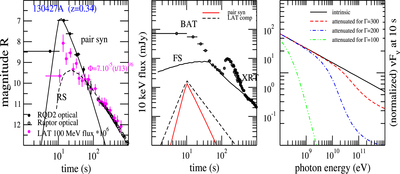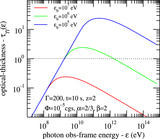Image Details

Caption: Figure 6.
Left panel: early optical and GeV emission for GRB 130427A and a fit to the optical flash (up to 100 s) with synchrotron emission from internal pairs formed in the shocked fluid. LAT fluence (model input) after the to = 10 s peak is indicated; LAT spectral slope is ﹩\beta =2.2﹩ (Tam et al. 2013). Model parameters are: source Lorentz factor before LAT peak ﹩{{{\Gamma }}_{o}}=300﹩, break-energy of the LAT spectrum ﹩{{\varepsilon }_{b}}=500\;{{(t/{{t}_{o}})}^{1/2}}﹩ keV, and the magnetic field parameter ﹩b={{10}^{-3}}﹩. The burst ambient medium is that of Equation (35), which sets the source dynamics: ﹩{\Gamma }(t)={{{\Gamma }}_{o}}{{(t/{{t}_{o}})}^{-1/4}}﹩. After 100 s, the optical emission is well-fit by the reverse-shock emission (Panaitescu et al. 2013). Mid panel: for the parameters of the optical flash fit, the pair emission is dimmer than the early X-ray emission of this burst, monitored by Swift’s BAT and XRT. The 10 keV emission from the LAT component with an assumed low-energy slope ﹩\alpha =2/3﹩ below ﹩{{\varepsilon }_{b}}﹩ is also shown. Part of the burst tail and early X-ray afterglow can be explained with the forward-shock emission. Right panel: photon–photon attenuated spectra (dashed lines) at the LAT peak light curve epoch, when attenuation is maximal, for the measured LAT spectrum (solid line) and various initial ﹩{{{\Gamma }}_{o}}﹩. For ﹩{{{\Gamma }}_{o}}=300﹩, a moderate absorption occurs above 10 GeV, corresponding to a flux reduction of at most 50%. For smaller ﹩{{{\Gamma }}_{o}}﹩, attenuation is stronger.
Copyright and Terms & Conditions
© 2015. The American Astronomical Society. All rights reserved.








